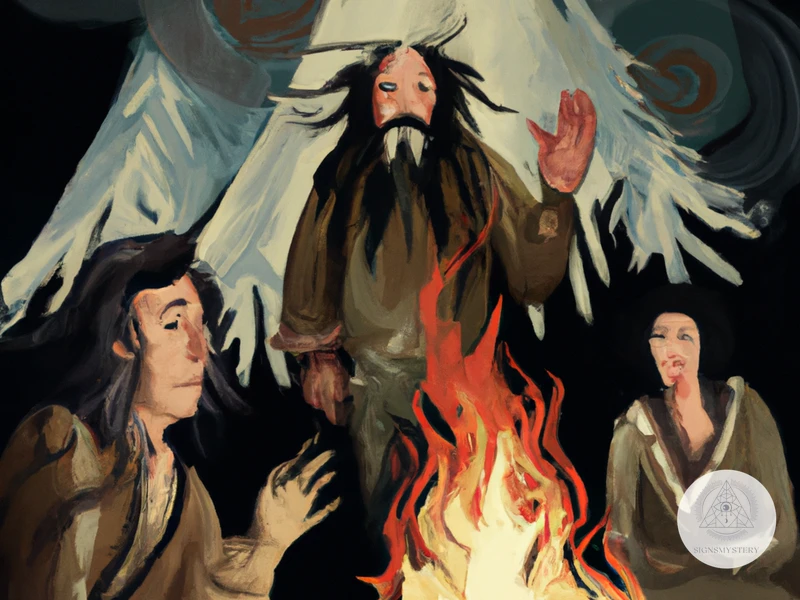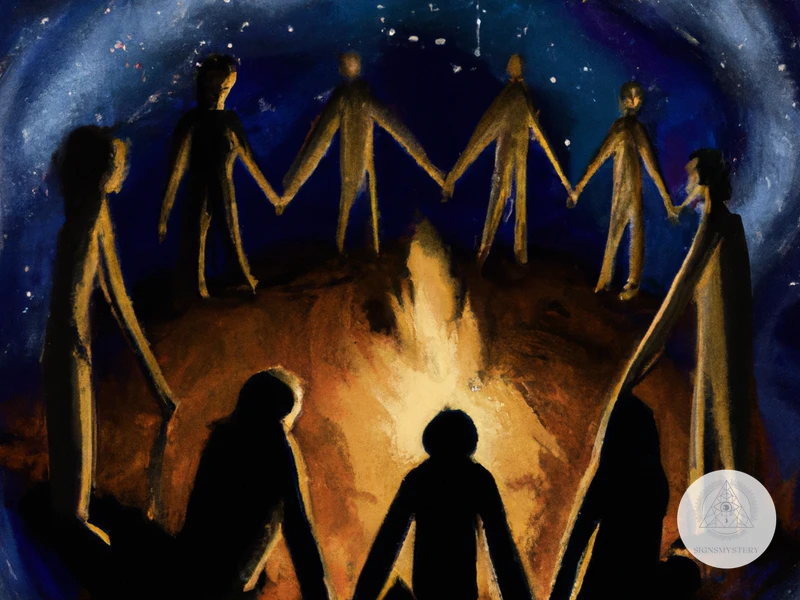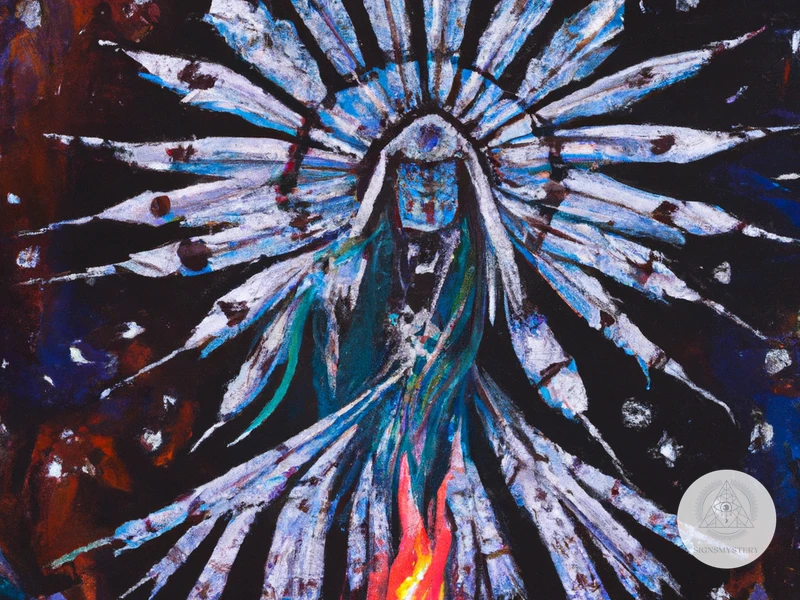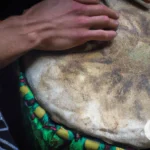The Role of Storytelling in Shamanic Traditions

In shamanic traditions, storytelling has played a vital role in passing down teachings, preserving cultural beliefs, and connecting with the spiritual world. Stories were used to transmit essential knowledge about the world and the cosmos, to understand the ways of nature, to heal and transform, and to connect with ancestors and spirits.
One of the crucial functions of storytelling in shamanic cultures is to preserve the oral tradition. Before the development of writing, stories were memorized and shared through oral transmission, passed down from generation to generation. This ensured that the cultural knowledge, history, and values were preserved and not lost to time.
In shamanic cultures, stories were often used to convey the myths and legends of creation, gods, spirits, and heroes. Myths were stories with deep symbolic meanings that explained the origins of the world and its inhabitants. Legends were tales of the supernatural or extraordinary events that helped shape the culture and beliefs. These tales served as metaphors for archetypal patterns of human experience and helped individuals understand their place in the world. To learn more about shamanic myths and legends, check out “Mythology in Shamanism”.
Storytelling was also used in shamanic traditions to pass on the ancestral wisdom and knowledge. Storytellers would recount the stories of their ancestors, their experiences, and their teachings, which helped individuals connect with their heritage and traditions. This connection to the past was considered vital, as it provided a sense of identity and meaning in life. To learn more about the relationship between shamanic culture and mythology, check out “Shamanic Mythology: Relationship between Culture and Myths”.
Storytelling in shamanic traditions served as a means of preserving the oral tradition, conveying sacred myths and legends, and transmitting the ancestral wisdom down the generations. It also helped individuals understand their place in the world, connect with their cultural heritage, and explore the spiritual realm. To learn more about the symbolism and interpretation of shamanic myths, check out “Shamanic Myths: Symbolism and Interpretation”.
1. Oral Tradition
Oral tradition has been a fundamental aspect of shamanic cultures for centuries, serving as a way to preserve sacred knowledge and wisdom. In shamanic traditions, stories are passed down from generation to generation through spoken word and governed by strict guidelines. Storytellers, who are typically revered members of their community, must adhere to the traditional structures and themes of the stories they tell. Oral tradition is also essential in maintaining a sense of cultural identity and belonging for many shamanic communities. Through stories, individuals can connect with their ancestors and understand their place in the world. In some cases, oral traditions can also serve as a method of historical documentation. The preservation and sharing of stories is a crucial component in preserving the rich traditions and cultures of indigenous peoples.
2. Sacred Myths and Legends
In shamanic traditions, sacred myths and legends play a crucial role in teaching and guiding individuals within the community. These stories often revolve around the creation of the world and its inhabitants, as well as tales of heroic deeds and journeys to other realms. Many myths and legends explore the relationship between humans, nature, and the divine.
One common motif found in shamanic myths is the use of mythic archetypes. These archetypes are universal symbols and characters that have been present in stories throughout human history. In many shamanic myths, these archetypes take on different forms and names, but their underlying meanings remain the same. For example, the archetype of the trickster can be found in many different cultures, from the Norse god Loki to the Native American Coyote.
Another important element in shamanic myths are animal spirits. These spirits are often seen as guides or teachers, and are believed to possess unique abilities and knowledge that can be imparted to humans. Animal spirits can appear in dreams, visions, or during shamanic journeys. Some common animal spirits include the eagle, bear, and wolf.
Symbolism is also a key component in shamanic myths. Many objects and natural phenomena carry symbolic weight, such as fire, water, and the sun. These symbols are often used to convey important spiritual concepts and can hold different meanings depending on the context.
Comparing and analyzing shamanic myths across different cultures can also bring insights into the commonalities and differences of shamanic practices. Understanding the relationship between religion, mythology, and shamanism can open up a deeper understanding of shamanic traditions and their origins.
The sacred myths and legends of shamanic traditions serve as a powerful tool for transmitting wisdom, preserving history, and connecting individuals to their community and spirituality.
3. Ancestral Wisdom
In shamanic traditions, storytelling plays an important role in passing down ancestral wisdom from one generation to the next. Ancestral wisdom refers to the collective knowledge, experiences, and beliefs of our ancestors, and it is through stories that this wisdom is preserved and shared.
One way that ancestral wisdom is conveyed through storytelling is by sharing myths and legends that have been passed down for centuries. These stories often contain powerful messages and teachings that are just as relevant today as they were when they were first told. For example, the myth of the hero’s journey is a common theme in shamanic myths and represents the transformative journey that individuals must undergo to achieve their full potential.
Another way that ancestral wisdom is shared through storytelling is by using symbolic language and metaphor. By using these tools of communication, the stories are able to convey deep, complex ideas and understanding that might be difficult to put into words otherwise. For example, many shamanic stories feature the use of animal spirits or mythical figures, which represent certain qualities or aspects of the human experience.
These stories often serve as a bridge to connect the present with the past. By looking at the stories that have been passed down through generations, we are able to gain insight into the beliefs, values, and cultural practices of our ancestors. We can also gain a greater understanding of our own place in the world and the role that our ancestors played in shaping our experiences.
Ancestral wisdom is an important part of shamanic storytelling and plays a critical role in understanding the deep spiritual practices of these ancient traditions. By exploring the myths and legends that have been passed down through generations, we can gain a greater appreciation for the complexities of shamanic practices and their enduring relevance today.
The Power of Storytelling to Connect with the Spiritual Realm
Storytelling has always had the power to transport people to another realm. In shamanism, stories give individuals the ability to journey to the spiritual realm. This is commonly known as a shamanic journey, where the listener is guided through the story to a place of spiritual significance. Through journeying with stories, one can connect with their spirit guides, ancestors, and other spiritual beings. This practice provides insight, guidance, and perspective to help individuals navigate their lives.
Telling stories can also be a way to invoke particular spirits. In shamanic traditions, spirits are often called upon to offer their assistance or provide guidance. By using stories that feature specific spirits, a shaman can invoke that spirit into the space they are in. For example, a story about a powerful bear spirit may be told in order to call upon the bear’s strength and wisdom.
Nature plays a significant role in shamanic traditions. Many Indigenous cultures view nature as a living, breathing entity that is connected to all beings. Stories about nature can help individuals connect with the spiritual realm and deepen their own connection to nature. By listening to stories about the natural world, individuals can learn about the spirits of plants, animals and other natural elements. This knowledge can help the listener develop a deeper understanding of their place in the natural world.
Storytelling is a powerful tool that can help individuals connect with the spiritual realm. By journeying with stories, invoking spirits with stories, and connecting with nature through stories, individuals can gain spiritual insight, guidance, and wisdom. To learn more about the myths and legends of shamanic traditions, check out our article on shamanic myths comparison for a deeper understanding of the symbolism in shamanic mythology, the mythic archetypes in shamanic practices, and the role of animal spirits in shamanic mythology.
1. Journeying with Stories
Journeying with stories is one of the essential tools of a shaman, and it involves traveling to the spiritual realm through stories. Storytelling allows the shaman to connect with the spirit world and access deeper knowledge and understanding. With each story, the shaman embarks on a new journey, gaining insights and wisdom to bring back to the physical world. These stories often contain powerful symbols and archetypes that resonate with the listener and evoke strong emotions and connections. By journeying with stories, the shaman can access the collective consciousness and connect with the spirits of ancestors, animals, and nature. For example, the story of the “trickster” in shamanic mythology represents the mischievous spirit that is present in all of us. By exploring this archetype in their journeying, the shaman can gain a deeper understanding of human nature and the role of humor in our lives.
2. Invoking Spirits with Stories
Invoking Spirits with Stories
One of the most significant aspects of storytelling within shamanic traditions is its ability to invoke spirits. Storytellers can use stories as a way to connect with different spirits, including animal spirits, nature spirits, and even ancestors. By invoking these spirits, the shaman can gain insights and guidance from the spiritual realm.
One common technique for invoking spirits is to use stories that feature the particular spirit the shaman wishes to contact. For example, if the shaman wishes to connect with the spirit of the bear, they may tell a story that features the bear as a central character. The story can be used to focus the shaman’s intentions and to draw the spirit closer.
Another technique for invoking spirits is to use stories with symbolic imagery and archetypes that resonate with the desired spirit. Shamanic stories often contain powerful symbols, such as the tree of life or the serpent, which can be used as a bridge between the spiritual and physical realms. In this way, the storyteller can create a direct portal to the spirit world.
In addition to invoking spirits, storytelling can also be used to honor and communicate with ancestors. By telling stories of the people who have come before, the shaman can connect with their lineage and tap into the wisdom and experiences of their predecessors. This practice can help to create a sense of continuity and connection between generations.
The ability to invoke spirits with stories is a powerful tool within shamanic traditions. By using the right stories and techniques, shamans can connect with a wide range of spirits, gain insight and guidance, and create a deeper sense of connection to the spiritual realm.
3. Connecting with Nature through Stories
In shamanic traditions, storytelling is not only a way to entertain or inform, but it can also be a way to connect with nature and the spiritual realm. Through storytelling, individuals can gain a deeper understanding of their connection to the natural world and the beings that inhabit it.
Many shamanic stories are centered around the natural world, such as tales of animals or mythical creatures. By listening to these stories, individuals can begin to see nature in a new light and develop a deeper appreciation for the environment around them. For example, the story of the “Tree of Life” is often used in shamanic practices to convey the interconnectedness of all living beings. This story emphasizes the importance of maintaining balance and harmony in nature as a way to honor the sacredness of all life.
Moreover, stories of animal spirits are also common in shamanic storytelling. Each animal holds a unique spiritual essence and is believed to have its own lesson or message that it can teach us. These stories allow individuals to connect with the qualities of different animals and learn from their wisdom. For instance, the tale of the “Bear Spirit” represents strength, courage, and power, and can be invoked during a shamanic ceremony to help an individual connect with these qualities.
Shamanic storytelling often includes stories that reflect the cyclical nature of life and the changing seasons. Through these stories, individuals can learn to recognize and honor the natural cycles of birth, growth, decay, and rebirth. An example of this is the story of the “Corn Mother,” which symbolizes the cycle of planting, harvesting, and regrowth. This story is often told during shamanic ceremonies to help individuals honor the natural cycles of life and death.
Overall, connecting with nature through storytelling is an essential part of shamanic tradition. Through these stories, individuals can develop a deeper understanding of their place in the natural world and how they can live in harmony with it. By incorporating these teachings into their daily lives, individuals can work to create a more balanced and sustainable future for both themselves and the planet.
Learn more about the significance of animal spirits in shamanic mythology here.
Storytelling as a Tool for Healing and Transformation

Storytelling has long been used as a powerful tool for personal growth and transformation in shamanic traditions. In this context, personal stories can be used to gain insight into our own experiences, emotions, and behavior patterns. By telling our stories, we can identify and address areas of our lives that need healing and growth.
For example, a shamanic practitioner might encourage a client to tell a story about a traumatic event in their life. By exploring the details and emotions of the story, the client can gain a deeper understanding of how the experience has impacted their life and how they can begin to move forward.
Through storytelling, individuals can also gain a greater appreciation for the interconnectedness of their experiences and the experiences of others. By examining the themes and patterns in our own stories, we can gain insight into the universal themes that connect us all. This can lead to a greater sense of empathy and understanding for others, as well as a greater sense of purpose and connection in our own lives.
In addition to using personal stories for self-reflection and growth, shamanic traditions also value the power of shared storytelling in healing trauma and promoting collective well-being.
In many shamanic cultures, stories are shared not only through individual storytelling, but also through communal rituals and ceremonies. By coming together to share stories and experiences, individuals can process shared trauma and find healing in community.
For example, in some Native American communities, the talking circle is a traditional gathering in which individuals take turns telling their stories while the others listen. This practice can be particularly powerful for healing trauma and promoting trust and empathy within the group.
Finally, shamanic traditions also recognize the powerful role that storytelling can play in inspiring new visions and shaping the future. By creating and sharing stories that reflect our collective values and aspirations, we can begin to imagine and work towards a better world.
In this way, storytelling can be a catalyst for transformative change in society. By sharing stories of hope, resilience, and transformation, we can inspire others to believe in the power of change and take action towards a more just and peaceful world.
Ultimately, storytelling is a central component of shamanic traditions for its ability to promote self-reflection, healing, and visionary inspiration. Whether through personal storytelling, communal rituals, or visionary storytelling, stories have the power to transform individuals and communities alike.
1. Using Personal Stories for Self-Reflection and Growth
Using personal stories is a powerful tool for self-reflection and growth in shamanic practice. By sharing our own experiences with others, we gain a deeper understanding of ourselves and our place in the world. Personal stories can also be used to identify patterns and themes in our lives, and to recognize how they influence our behavior. Self-awareness is key to personal growth, and storytelling is a way to achieve it in a profound way. One way to work with personal stories is through journeying, which involves entering into a trance state through drumming or other techniques. During this state, we can gain insights into our own experiences and uncover hidden aspects of ourselves. This can be a transformative experience, leading to healing and growth.
2. Healing Trauma through Shared Storytelling
Shared storytelling is a powerful tool in shamanic practices for healing trauma. Through storytelling, individuals can connect with others and share their experiences in a safe and supportive environment. When trauma is experienced, it can be difficult for an individual to process and overcome it alone. By sharing their story with others, the individual can gain a new perspective and understanding of their experiences, and feel a sense of relief and validation.
In shamanic traditions, shared
Subscribe to Our Newsletter
Sign up to receive the latest news and updates.
One way that shared storytelling is used for healing in shamanic practices is through the use of mythic archetypes. These archetypes, which are common themes or characters found in mythology and storytelling across cultures, can help individuals understand their experiences and find meaning in their trauma. By connecting their personal story to a universal theme, individuals can gain a new perspective on their journey and feel a sense of connection to something greater than themselves.
Another way that shared storytelling can aid in healing trauma is by using symbolism. Symbolism is an important aspect of shamanic mythology and often holds deep spiritual and emotional significance. By exploring the symbolism in their personal story, individuals can gain a deeper understanding of their trauma and connect with the spiritual realm. This can lead to a sense of spiritual healing and transformation.
It’s important to note that shared storytelling should always be done in a safe and supportive environment, with a trained facilitator or shaman. It’s also important to respect the privacy and confidentiality of the participants, and to create a space where everyone feels comfortable sharing.
Shared storytelling is a powerful tool in shamanic practices for healing trauma. Through the use of mythic archetypes and symbolism, individuals can gain new perspectives on their experiences and connect with something greater than themselves. By sharing their stories in a safe and supportive environment, individuals can find healing, validation, and transformation.
3. Creating New Stories for Visionary Inspiration
Creating New Stories for Visionary Inspiration is an essential aspect of shamanic storytelling. In traditional shamanic practices, stories were not just told for entertainment or historical purposes, but they were used as a tool for spiritual growth and transformation. Creating new stories was a way for shamans to convey powerful messages, visions, and teachings to their followers.
One way of creating new stories is through personal experience. As modern shamans continue to explore their spiritual path, they can use their personal experiences as the foundation for new stories that can inspire others. Personal experiences that involve visions, dreams, or journeys to the spiritual realm can be transformed into stories, creating an opportunity for deep reflection and inspiring insights.
Another technique for creating new stories is to draw on mythic archetypes and symbolism from shamanic mythology. Myths and legends are powerful, and they have been used for centuries to convey universal truths and spiritual teachings. Shamans can access the symbolism and archetypes in these stories and create new narratives that inspire and transform.
Creating new stories can also be a way for shamans to reimagine traditional stories in a contemporary context. By taking familiar myths and legends and putting a modern twist on them, shamans can breathe new life into old tales, making them more relevant to contemporary audiences.
Some shamans also use art forms like writing, painting, and music to create new stories. These art forms allow for creative expression that can be used to convey powerful spiritual messages. In fact, many of the most influential spiritual teachings have been disseminated through music, literature, and art.
Creating new stories is just one aspect of shamanic storytelling. By using personal experience, mythic archetypes, symbolism, and other creative techniques, shamans can inspire and transform their followers on their spiritual journey.
The Art of Storytelling in Shamanism
The art of storytelling is an essential part of shamanism. Through storytelling, shamans share wisdom, transmit cultural knowledge, and connect with the spiritual realms. The most powerful stories contain elements of magic, transformation, and archetypal symbolism. The use of symbolism is especially crucial in shamanic mythologies as it is a way for the myths to transcend time and place. The archetypal motifs are present in many shamanic practices, representing the collective unconscious of individuals and culture. Storytelling techniques such as vocalization, repetition, and visualization help to guide the listener into deeper states of consciousness. Incorporating the art of storytelling into your shamanic practice can enhance and enrich your experience by enabling you to connect with the spiritual realm on a deeper level.
1. Elements of a Powerful Story
A powerful story is the cornerstone of any shamanic tradition. It is what provides the framework for beliefs, values, and practices. Stories are told not only to entertain but also to impart knowledge and to heal. Here are some of the elements that make a powerful shamanic story:
| Element | Description |
|---|---|
| Symbolism | A powerful story is full of symbolic meaning that can be interpreted on multiple levels. It often uses symbolic language and imagery to convey complex concepts. |
| Archetypes | Archetypal elements are often present in powerful shamanic stories. These archetypes are universal patterns of behavior that are present in all cultures. |
| Emotion | A powerful story evokes strong emotions in the listener. Emotions are an important part of the shamanic experience and can be used to heal and transform the individual. |
| Cultural Relevance | A powerful story is relevant to the culture in which it is told. It often speaks to the struggles and triumphs of the people and helps to reinforce cultural values and beliefs. |
| Universal Themes | Powerful shamanic stories often deal with universal themes such as death, rebirth, love, and transformation. They speak to the human experience and help individuals connect with one another. |
Understanding these elements is key to crafting a powerful shamanic story that can help individuals on their journey towards healing and transformation. For more information on the symbolism and archetypes present in shamanic mythology, check out our article on Symbolism in Shamanic Mythology.
2. Storytelling Techniques and Rituals
In shamanism, storytelling is considered an art form and a powerful tool for healing and transformation. Storytelling techniques and rituals play an essential role in creating a sacred space for the listener to connect with the spiritual realm.
One common technique is the use of repetition. The shamanic storyteller may repeat certain phrases or words throughout the story to create a trance-like state in the listener. This can help to deepen their connection with the story’s message and allow them to enter a more receptive state for healing or transformation.
Another technique is the use of symbolism. The shamanic storyteller may include symbols such as animals, nature, or mythical creatures to convey deeper meanings and messages. These symbols can provide insight into the listener’s own spiritual journey and offer guidance for their path.
Rituals also play an important role in storytelling in shamanic traditions. The use of ritual objects such as feathers, drums, or crystals can help to enhance the energetic connection between the storyteller and the listener. The storyteller may also perform a ritual before beginning the story to honor the spirits and invite their guidance and protection.
Many shamanic cultures have specific rituals for storytelling, such as the use of a storytelling circle or a fire ceremony. In these rituals, the storyteller is often seen as a conduit for the spirit world, and their storytelling is a sacred act of communicating the wisdom of the ancestors and spirits.
Incorporating these storytelling techniques and rituals into your own shamanic practice can enhance your connection with the spiritual realm and help to facilitate healing and transformation for yourself and others. By honoring the power of storytelling and the wisdom of the ancestors, we can learn to connect more deeply with our own inner wisdom and the spiritual realm beyond us.
To dive deeper into the topic of the use of mythic archetypes, and how storytelling can play a vital role in shamanic practices, check out our article on mythic archetypes in shamanic practices. Also, our article on religion, mythology and shamanism explores the connections between these three areas and how they influence each other.
3. Incorporating Storytelling into Your Shamanic Practice
Incorporating storytelling into your shamanic practice can add a powerful dimension to your spiritual journey. Here are some ways to do it:
1. Find and learn traditional stories: Shamanic traditions have a rich history of myths, legends, and stories that are passed down orally from generation to generation. Find and learn these stories, and consider how you can incorporate them into your practice. These stories often contain important teachings and symbolism that can enrich your understanding of shamanic practices.
2. Use storytelling as a form of meditation: Sit in a quiet place and allow yourself to be fully immersed in a story. Visualize the setting and characters and allow the story to unfold in your mind. This can be a powerful form of meditation that can help you connect with your spiritual self.
3. Share stories with others: Gather with other practitioners and share stories. This can be a great way to build community and create a deeper sense of connection. Sharing stories can also help you to discover new perspectives and insights.
4. Create your own stories: Experiment with creating your own shamanic stories. This can be a powerful tool for tapping into your creativity and connecting with the spiritual realm. Consider incorporating elements of your personal journey and experiences into your stories.
5. Use stories in rituals and ceremonies: Incorporate traditional stories or your own stories into your shamanic rituals and ceremonies. This can add depth and meaning to your practice and help you to connect with the spiritual forces that you are working with.
Storytelling can be a powerful tool for deepening your shamanic practice. By incorporating traditional stories, using storytelling as a meditation practice, sharing stories with others, creating your own stories, and using stories in rituals and ceremonies, you can enhance your understanding and connection with shamanic traditions.
Conclusion
In conclusion, storytelling is an integral part of shamanic traditions that serves many important purposes. It is not only a means of passing down knowledge and wisdom from one generation to the next but also a powerful tool for connecting with the spiritual realm, promoting healing and transformation, and inspiring visionary experiences. By understanding the role of storytelling in shamanic practices, we can better appreciate the depth and complexity of these ancient traditions.
Throughout this article, we have explored various aspects of storytelling in shamanism, including the importance of oral tradition, the power of connecting with the spiritual realm through stories, and the use of personal stories for self-reflection and growth. We have also examined the art of storytelling in shamanism, including the elements of a powerful story and the various techniques and rituals used to tell stories in a sacred manner.
As you incorporate storytelling into your own shamanic practice, it is essential to remember that it is not just about telling a story. It is crucial to tell the story in a way that is experiential and impactful for the listener. Storytelling is an art, and like all art forms, it requires practice and intention.
To summarize, the benefits of storytelling in shamanic traditions are numerous and should be embraced by anyone seeking to deepen their understanding of these ancient practices. Whether you are just beginning your shamanic journey or have been practicing for years, incorporating storytelling into your practice can be a powerful way to connect with the divine, promote healing and transformation, and inspire visionary experiences. Remember, the story is not just a story. It is a sacred tool for accessing the wisdom of the ancestors and connecting with the spiritual realm.
Frequently Asked Questions
What is the role of storytelling in shamanic traditions?
Storytelling is an integral part of shamanic traditions as it helps preserve cultural history, impart tribal wisdom, connect with the spiritual realm, heal trauma, and inspire visionary experiences.
How does shamanic storytelling differ from other forms of storytelling?
Shamanic storytelling aims to convey metaphysical concepts and spiritual teachings through imagery and symbolism. It often involves invoking spirits, connecting with nature, and exploring the journey of the soul.
What are some examples of sacred myths and legends in shamanic storytelling?
Examples of sacred myths and legends in shamanic storytelling include creation stories, tales of heroic deeds, and accounts of transformative journeys to the spirit world.
How can storytelling be used for healing and transformation?
Storytelling can help individuals confront and process traumatic experiences, gain deeper self-awareness and personal insights, and tap into their own creative potential for transformative change.
What are some storytelling techniques used in shamanic traditions?
Techniques used in shamanic storytelling include the use of repetition, metaphor, symbolism, and dramatic tension to build a connection between the storyteller and the listener.
What is the importance of ancestral wisdom in shamanic storytelling?
Ancestral wisdom is an essential component of shamanic storytelling as it helps promote cultural identity, provides guidance on navigating the natural world, and imparts knowledge of the spiritual realm and its inhabitants.
What is the power of storytelling in shamanism?
The power of storytelling in shamanism lies in its ability to create a bridge between the physical and spiritual worlds, providing insight, wisdom, and inspiration to those who participate in the storytelling experience.
How can storytelling be incorporated into a personal shamanic practice?
Storytelling can be incorporated into a personal shamanic practice through the use of guided meditations, vision quests, and other techniques that invite participants to journey to the spirit world and explore their own personal narratives.
What are some elements of a powerful shamanic story?
Elements of a powerful shamanic story include vivid imagery, a compelling narrative arc, deep emotional resonance, and the ability to evoke a sense of mystery and wonder in the listener.
How does storytelling help connect shamanic practitioners with nature?
Storytelling helps connect shamanic practitioners with nature through its ability to evoke the sights, sounds, and sensations of the natural world. Through storytelling, practitioners can gain a deeper appreciation for the interconnectedness of all living things and cultivate a sense of reverence for the earth and its inhabitants.










